

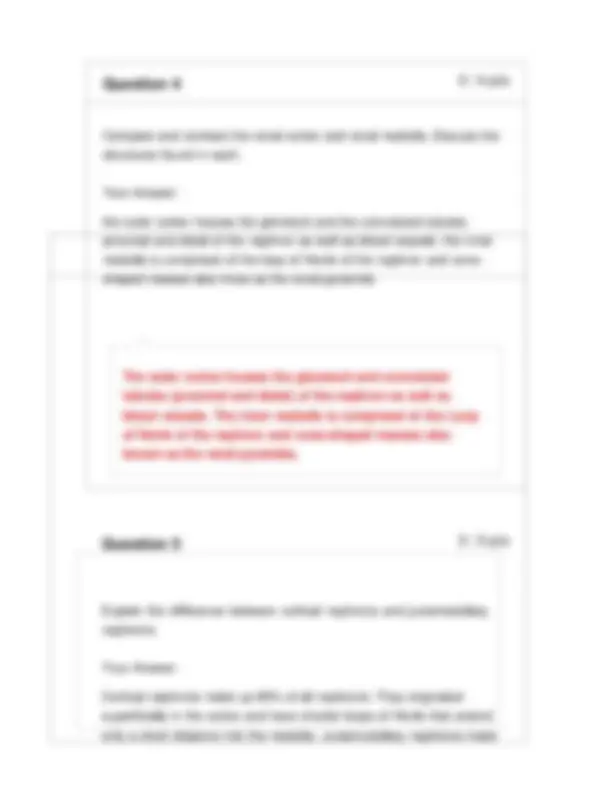
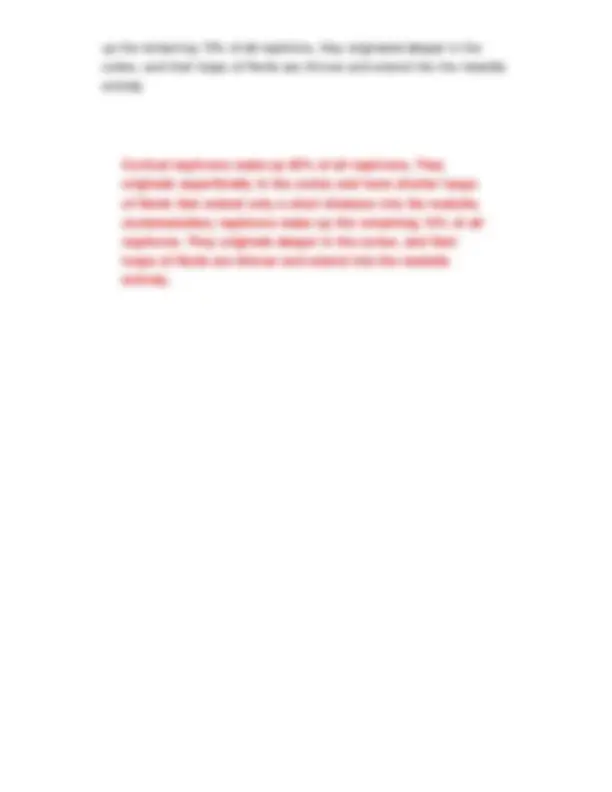











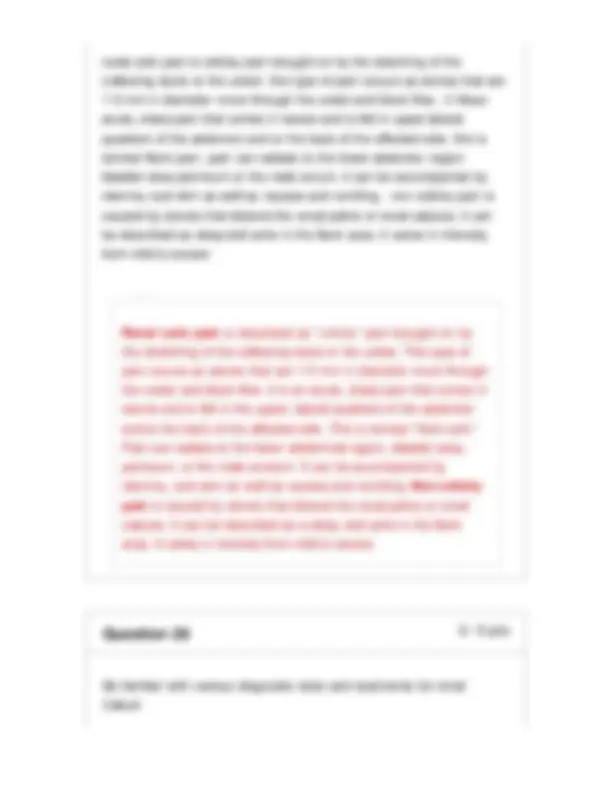



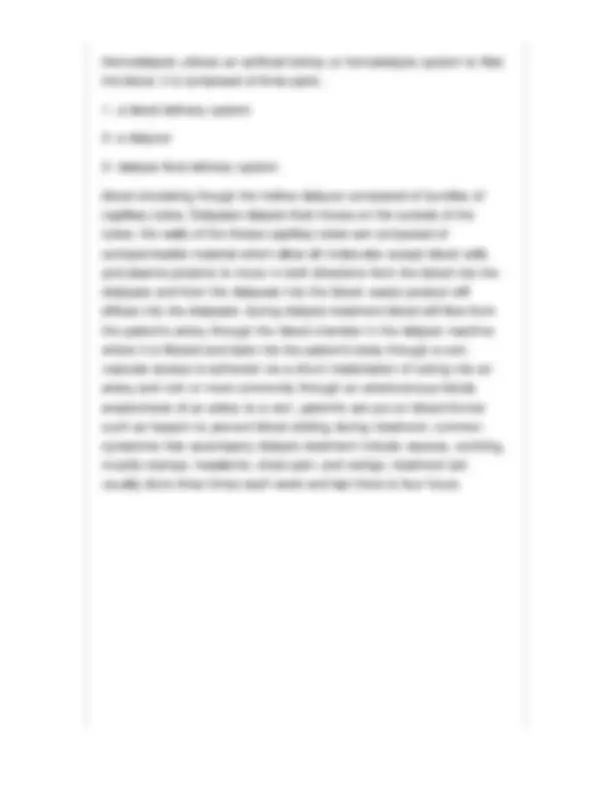
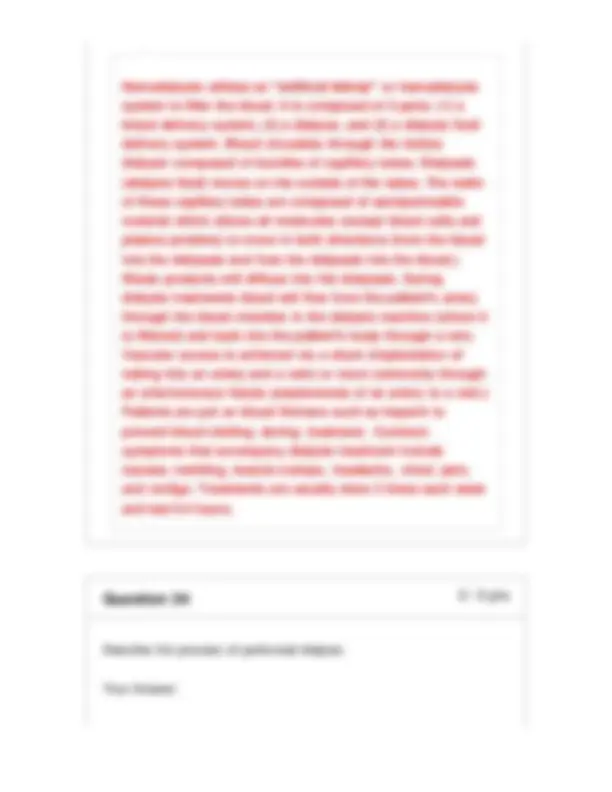




Study with the several resources on Docsity

Earn points by helping other students or get them with a premium plan


Prepare for your exams
Study with the several resources on Docsity

Earn points to download
Earn points by helping other students or get them with a premium plan
Community
Ask the community for help and clear up your study doubts
Discover the best universities in your country according to Docsity users
Free resources
Download our free guides on studying techniques, anxiety management strategies, and thesis advice from Docsity tutors
Due No due date Points 5 Questions 36 Time Limit None Attempt History Attempt Time Score LATEST Attempt 1 15,574 minutes 5 out of 5 Score for this quiz: 5 out of 5 This attempt took 15 minutes. The hilus is a concave cleft, and it is at this point where the ureters, blood vessels, and nerves enter the kidney. Your Answer: the hilus is a concave clef of the kidney, and it is the point where the ureters, blood vessels, and nerves enter the kidney Describe the location of the hilus and its significance. Question 1 0 / 0 ptsDescribe the functions of the nephron. Your Answer: the function of the nephron is to control the concentration of the water and the soluble materials by filtering the blood, reabsorbing needed materials and excreting waste products as urine, the nephron hereby eliminates wastes from the body, regulates blood volume, PH and pressure , and controls the levels of electrolytes The function of the nephron is to control the concentration
Typology: Exams
1 / 30

This page cannot be seen from the preview
Don't miss anything!























Attempt Time Score LATEST Attempt 1 15,574 minutes 5 out of 5
This attempt took 15 minutes. The hilus is a concave cleft, and it is at this point where the ureters, blood vessels, and nerves enter the kidney. Your Answer: the hilus is a concave clef of the kidney, and it is the point where the ureters, blood vessels, and nerves enter the kidney Describe the location of the hilus and its significance.
Describe the functions of the nephron. Your Answer: the function of the nephron is to control the concentration of the water and the soluble materials by filtering the blood, reabsorbing needed materials and excreting waste products as urine, the nephron hereby eliminates wastes from the body, regulates blood volume, PH and pressure , and controls the levels of electrolytes The function of the nephron is to control the concentration of water and soluble materials by filtering the blood, reabsorbing needed materials and excreting waste products as urine. The nephron thereby eliminates wastes from the body, regulates blood volume, pH and pressure, and controls the levels of electrolytes.
Explain the difference between cortical nephrons and juxtamedullary nephrons. Your Answer: Cortical nephrons make up 85% of all nephrons. They originated superficially in the cortex and have shorter loops of Henle that extend only a short distance into the medulla. Juxtamudullary nephrons make The outer cortex houses the glomeruli and convoluted tubules (proximal and distal) of the nephron as well as blood vessels. The inner medulla is comprised of the Loop of Henle of the nephron and cone-shaped masses also known as the renal pyramids. Compare and contrast the renal cortex and renal medulla. Discuss the structures found in each. Your Answer: the outer cortex houses the glomeruli and the convoluted tubules
medulla is comprised of the loop of Henle of the nephron and cone- shaped masses also know as the renal pyramids
up the remaining 15% of all nephrons. they originated deeper in the cortex, and their loops of Henle are thinner and extend into the medulla entirely Cortical nephrons make up 85% of all nephrons. They originate superficially in the cortex and have shorter loops of Henle that extend only a short distance into the medulla. Juxtamedullary nephrons make up the remaining 15% of all nephrons. They originate deeper in the cortex, and their loops of Henle are thinner and extend into the medulla entirely.
Fenestrations and podocytes Your Answer: 1 - Podocytes 2 - Fenestrations Name two specialized structures of the glomerular capillaries that contribute to the filtration of blood.
List the 4 segments of the nephron tubule. Your Answer: 1 - the proximal convoluted tubule, drains Bowman capsule 2 - The loop of Henle
The collecting tubule
(1) the proximal convoluted tubule (highly coiled) which drains Bowman capsule; (2) the loop of Henle; (3) the distal convoluted tubule; and (4) the collecting tubule which joins with other nephron tubules to collect the filtrate. (1) filtration (2) reabsorption and (3) secretion. Filtration takes place in the renal corpuscle; reabsorption and secretion occur in the renal tubules. Your Answer: filtration, occurs in the renal corpuscle
3 - secretion, occurs in the renal tubules What are the 3 processes involved in urine formation? Describe where they occur.
What is the norm value for the GFR? Discuss why maintenance of this value is important.
List 3 ways that the kidney acts as an endocrine organ. Your Answer: through the renin angiotensin aldosterone system RAA- 2 through the regulation of red blood cell production through the formation of erythropoietin, and through calcium metabolism by the activation of vitamin D (1) through the renin-angiotensin-aldosterone system (RAA) (2) through the regulation of red blood cell production through the formation of erythropoietin, and (3) through calcium metabolism by the activation of vitamin D. Be familiar with the RAA system and Figure 8. Be familiar with the process of tubular reabsorption and Figures 8.5 and
Describe the action of ADH. Your Answer: ADH acts on the collection tubule to increase water absorption.ADH inhibits urine output by increasing the number of water channels in the cell membrane of the collecting ducts ADH acts on the collecting tubule to increase water absorption. ADH inhibits urine output by increasing the number of water channels in the cell membrane of the collecting ducts.
Aldosterone acts to place several types of ion channels inside the cells of the collecting ducts. One type of ion channel is a sodium-hydrogen ion channel. Aldosterone increases Na+ reabsorption through the excretion of H+ ions. Na+ ions are pumped out of the filtrate while hydrogen ions are pumped inside and then excreted. Because water follows salt, Na+ reabsorption will cause water reabsorption. Aldosterone will also increase K+ secretion
be returned to the blood while potassium (K+) is excreted in urine. The main action of aldosterone is to increase the blood volume and, therefore, blood pressure when needed. Hyponatremia occurs when plasma concentration falls below 135 mEq/L. Your Answer: Hyponatremia occurs when plasma concentration falls below 135mEq/L Define hyponatremia using blood values.
Be familiar with hyponatremia pathology, clinical presentation, and treatment. Hypernatremia occurs when plasma Na+ levels rise above 145 mEq/L with a serum osmolality greater than 295 mOsm/kg. Your Answer: Hypernatremia occur when plasma Na+ levels rise above 145 mEq/L with a serum osmolality greater than 295 most/kg. Define hypernatremia using blood values.
Be familiar with hypernatremia pathology, clinical presentation, and treatment.
Be familiar with hyperkalemia pathology, clinical presentation, and treatment.
mg/dL. Your Answer: Hypocalcemia is the result of Ca2+ levels falling below 8.5 mg/dL Define hypocalcemia using blood values.
Be familiar with hypocalcemia pathology, clinical presentation, and treatment. Define hypercalcemia using blood values.
Your Answer: Hypercalcemia occurs when plasma Ca2+levels are greater than 10. mg/dL Hypercalcemia occurs when plasma Ca2+ levels are greater than 10.5 mg/dL. Be familiar with hypercalcemia pathology, clinical presentation, and treatment. Hypomagnesemia occurs when plasma Mg2+ concentration is less than 1.8 mg/dL. Your Answer: Hypomagnesemia occurs when plasma Mg2+ concentration is less than 1.8 mg/dL Define hypomagnesemia using blood values.
Your Answer: chemical buffer system the brain stem respiratory center 3 - the renal system Blood pH is controlled by three main methods in the body:
respiratory center, and (3) the renal system. Be familiar with Table 8.2 and be able to determine whether a patient is in respiratory or metabolic acidosis/alkalosis and compensatory mechanism. What are the common causes of acute postinfectious
Your Answer: acute Postinfectious Glomerulonephritis occurs as the another infection including streptococcus and staphylococcus bacterial infection, viral infection such as hepatitis , and even parasitic infections.
Discuss risk factors for the formation of renal calculi. Your Answer: the levels of the stone components in the blood and the urine, anatomical changes of the urinary tract structures , metabolic, and endocrine function, dietary , intestinal absorption ,past history UTIs, and supersaturated urine. The levels of stone components in the blood and urine, anatomical changes of the urinary tract structures, metabolic and endocrine function, dietary and intestinal absorption, past history of UTIs, and supersaturated urine. Acute Postinfectious Glomerulonephritis occurs as the result of another infection including streptococcus and staphylococcus bacterial infections, viral infections such as hepatitis, and even parasitic infections. Be able to list and describe the 4 types of kidney stones.